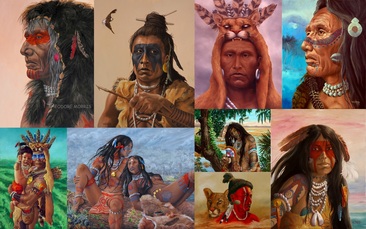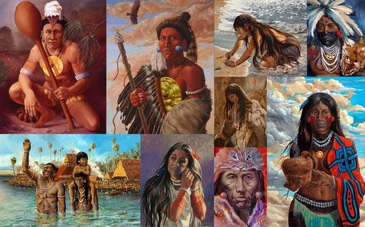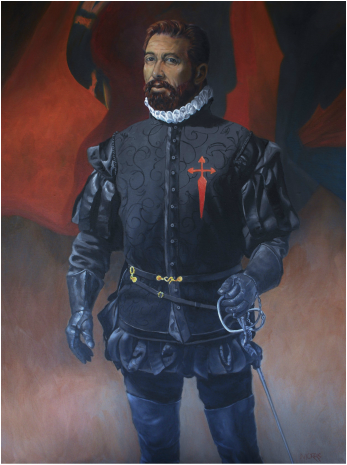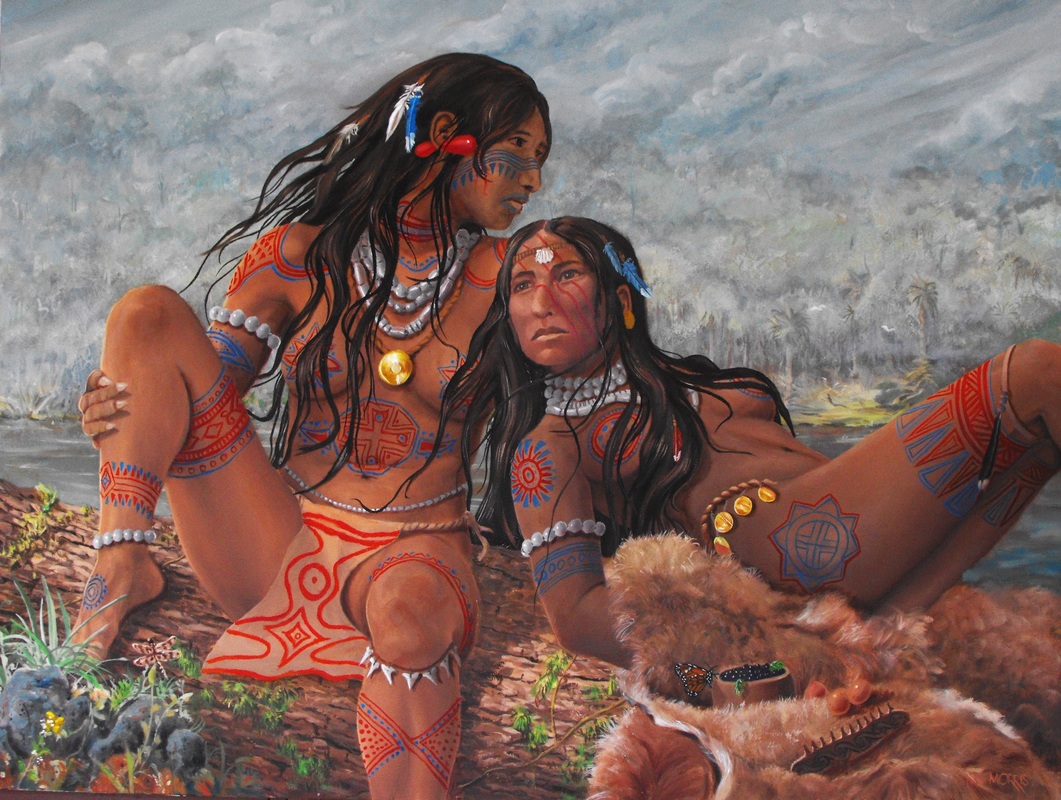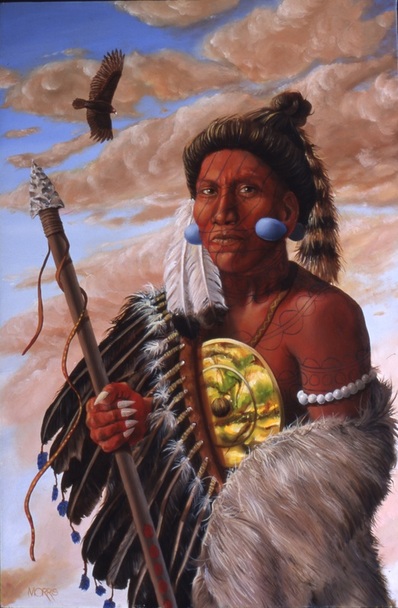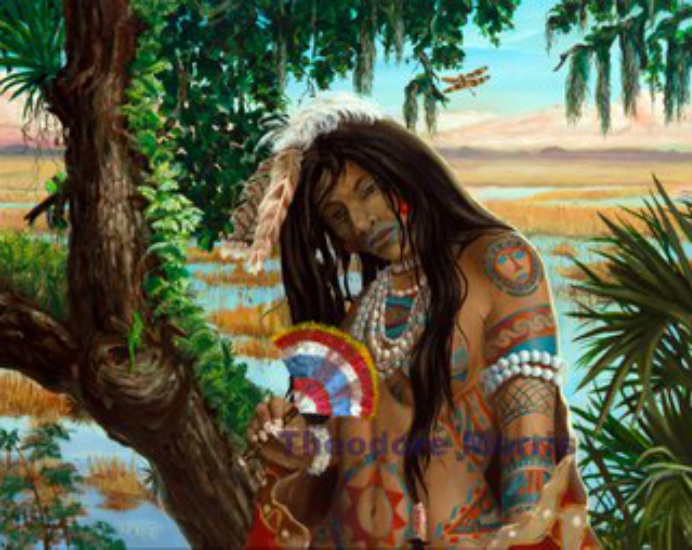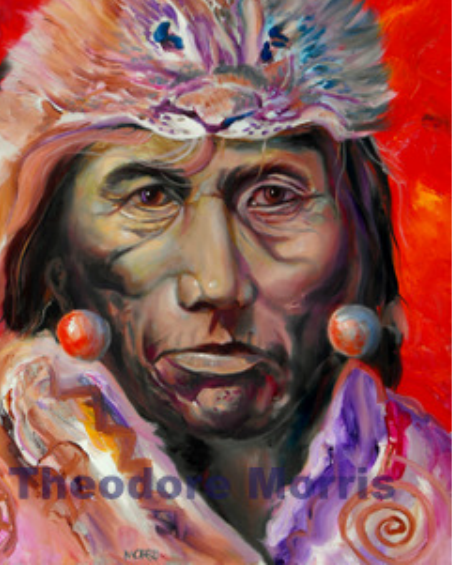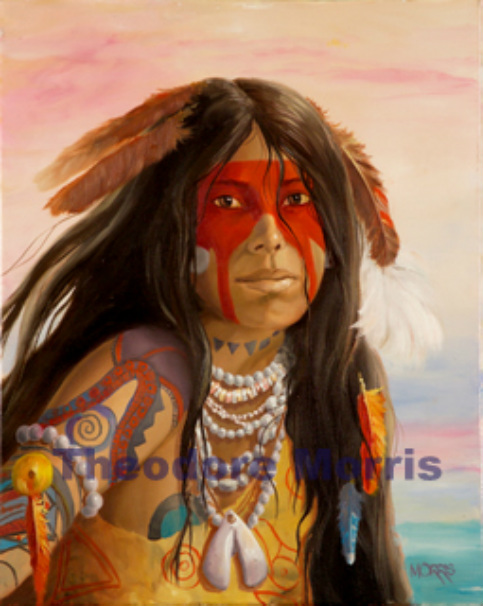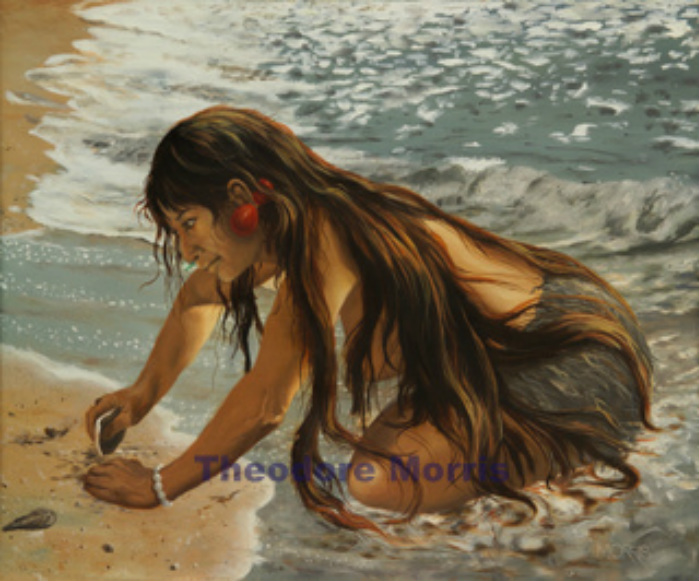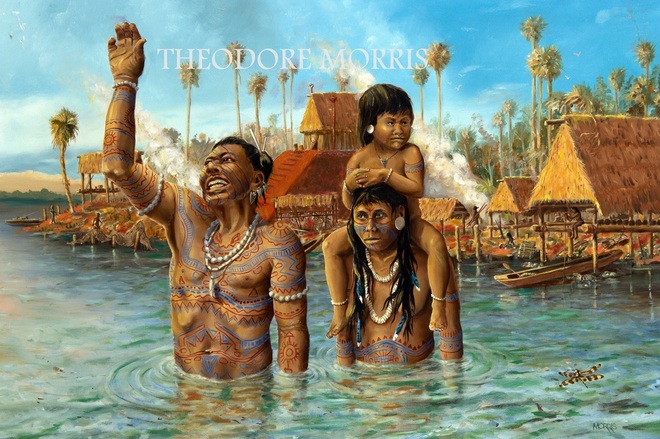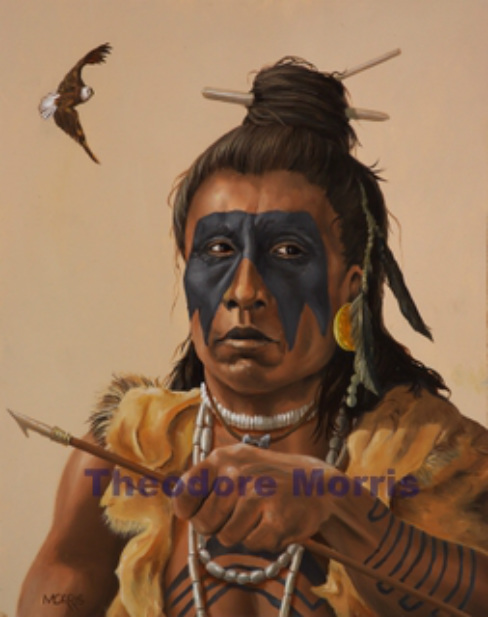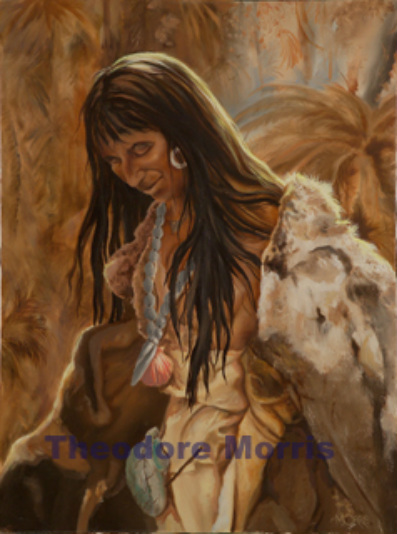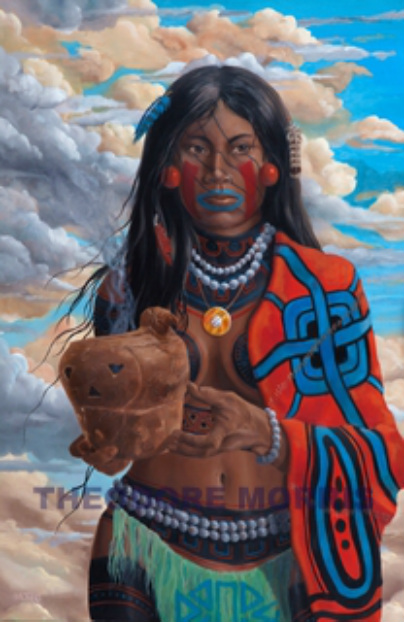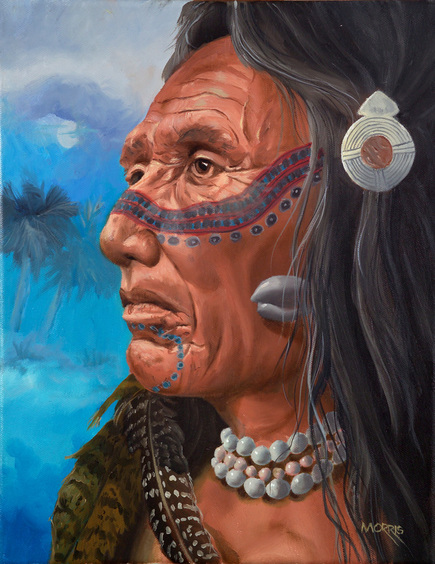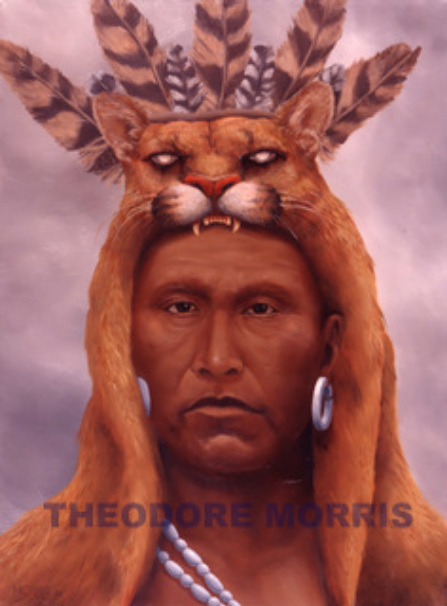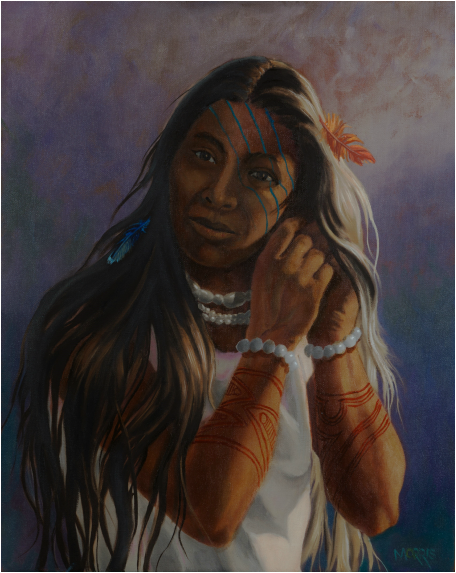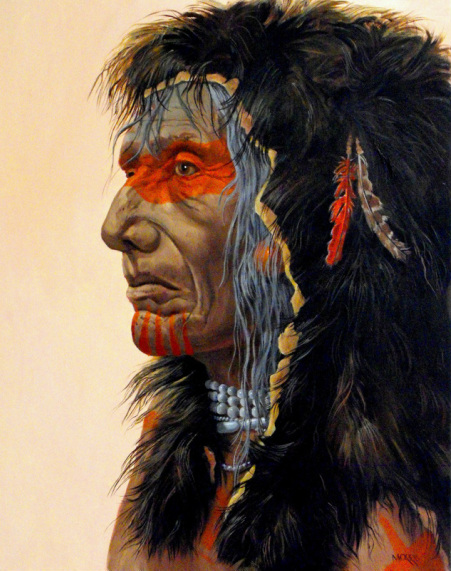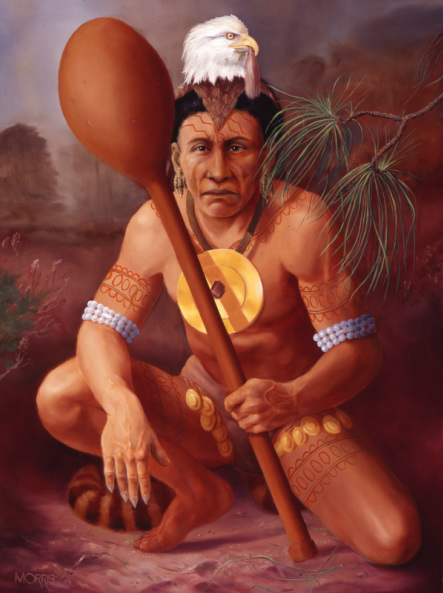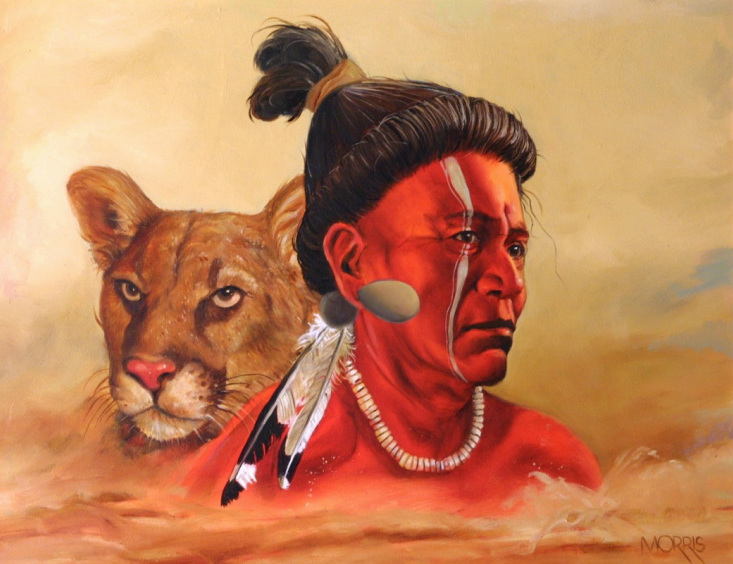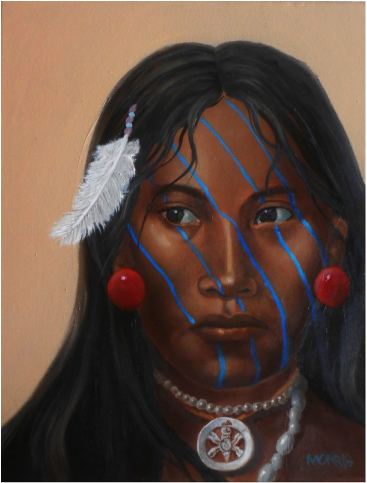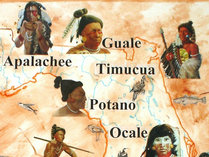
Timucua The Timucua Indians were spread across parts of northern Florida and southeastern Georgia. Their territory was large and consisted of many different environments. Beaches, salt marshes, and forests thrived near the Atlantic coast. Rivers, lakes, swamps, and woodlands covered inland areas. The Timucua were not a single tribe, but rather separate groups, who spoke dialects or types of the Timucua language. For example, the Mocama dialect was spoken by the coastal Timucua near Jacksonville, while the Potano dialect was spoken by the inland Timucua near Gainesville.
Because of Florida’s hot climate, the Timucua wore little clothing. Men dressed only in deerskin breechcloths. Their long black hair was tied in topknots, and their faces and bodies were decorated in brightly colored markings. Some of these tattoos were permanent, while others could be washed away. Women wore skirts of Spanish moss. Their long hair hung loose down their backs. Some women also had tattoos. Both men and women wore bracelets and necklaces of animal bone, teeth, and shell. Colored bird feathers might be placed in their hair during special events. Animal fur capes or robes provided warmth in the winter.
Because of Florida’s hot climate, the Timucua wore little clothing. Men dressed only in deerskin breechcloths. Their long black hair was tied in topknots, and their faces and bodies were decorated in brightly colored markings. Some of these tattoos were permanent, while others could be washed away. Women wore skirts of Spanish moss. Their long hair hung loose down their backs. Some women also had tattoos. Both men and women wore bracelets and necklaces of animal bone, teeth, and shell. Colored bird feathers might be placed in their hair during special events. Animal fur capes or robes provided warmth in the winter.
30" 40" OIL ON CANVAS $7,200

Pedro Menéndez de Avilés (15 February 1519–17 September 1574) was a Spanish admiral and explorer from the region of Asturias, Spain, remembered for planning the first regular trans-oceanic convoys and for founding St. Augustine, Florida in 1565. This was the first successful Spanish settlement in La Florida and the most significant city in the region for nearly three hundred years. He was welcomed by the chief of the Timucua village of Seloy, where he stayed for a year. St. Augustine is the oldest continuously inhabited European -established settlement in the continental United States. Menéndez subsequently became the first governor of Florida.
Timucua Girls
When the French arrived in Florida in 1564, they brought few available women. The single men sought companionship from single Indian maidens. Neither the native girls nor their fathers opposed matches between an Indian girl and a Frenchman. I painted the background with neutral colors to emphasize the two figures in the foreground.
ARTIFACTS & OBJECTS
ARTIFACTS & OBJECTS
- Assorted bird feather
- Dyed fish bladder ear decorations
- Tattoos
- Shell beads
- Shell pendant with leather strap
- Copper ear plug
- Copper pendant
- Painted deerskin
- Sharks teeth knee band
- Ceramic pot & carved bone comb
- Deer & buffalo pelts
- “for adornment they have their skin tattooed in a bizarre pattern that they have no clothing, the men no more than the women, but that the woman gird themselves with a little covering from the skin of a deer or other animal, the knot being tied over the thigh on the left side in order to cover the more private part of their natural endowment...”
Chief Outina
This Timucua chief was described in 1564 by the French artist Jacques le Moyne as being painted red and walking alone in solitary grandeur in the middle of his warriors. I painted a warm umber color in the background to suggest his god-like powers. The turkey vulture in the sky connects spiritually and naturally to the feathers he wears.
ARTIFACTS & OBJECTS
"...govern their republics as head with the assistance of counselors...determines and reaches decisions on everything that is appropriate for the village and the common good..."
(Father Francisco Alonso de Jesus, 1630)
ARTIFACTS & OBJECTS
- Turkey vulture bird
- Raccoon tail
- Eagle feathers
- Tattoos
- Painted fish bladder ear ornaments
- Turkey vulture feathers
- Copper breast plate
- Shell beads
- Deer hide robe
- Chert spear point
- Painted deer hide straps
"...govern their republics as head with the assistance of counselors...determines and reaches decisions on everything that is appropriate for the village and the common good..."
(Father Francisco Alonso de Jesus, 1630)
Chief Saturiba's Queen
This Queen stands framed against the strikingly beautiful saltwater marshes of Ft. George Island near the St. Johns River. Island living had many benefits including security from attacks by other tribes and the easy gathering of seafood and marsh animals. She is one with her environment as she gazes out from the shady coolness of a shoreline tree covered with ferns. I liked the contrast between the figure and the hot glaring sunlit background.
ARTIFACTS AND OBJECTS
“All these chiefs and their wives paint the skin around their mouths blue and are tattooed on the arms and thighs with a certain herb which leaves an indelible color. This process is so severe that it sometimes makes them sick for 7 or 8 days.”
(Jacques le Moyne, 1564)
ARTIFACTS AND OBJECTS
- Egret, hawk, pelican feathers
- Tattoos
- Shell beads Feather fan
- Painted deerskin robe
- Olive shell
- Cypress tree with resurrection ferns
“All these chiefs and their wives paint the skin around their mouths blue and are tattooed on the arms and thighs with a certain herb which leaves an indelible color. This process is so severe that it sometimes makes them sick for 7 or 8 days.”
(Jacques le Moyne, 1564)
Bobcat Clan Member
This war leader wears a bobcat pelt on his head that signifies he is a member of the Bobcat Clan. I painted the bright red background and brightly painted deer skin to emphasize the energy still associated with this old tribal member. As he gazes at the viewer, he recalls all the changes he has seen with the arrival of the Europeans.
ARTIFACTS & OBJECTS
· Bobcat pelt head
· Fish bladder ear decorations
· Painted deer skin
“The natives at St. Augustine and San Mateo are very treacherous and deceitful...especially since they feign friendship with the Christians for their own immediate ends. If they are not given food, clothing, iron axes, and other presents when they come to the forts, they leave in a great rage, go on the warpath, and kill any Christians they encounter.”
(Pedro Menendez de Aviles, 1567)
ARTIFACTS & OBJECTS
· Bobcat pelt head
· Fish bladder ear decorations
· Painted deer skin
“The natives at St. Augustine and San Mateo are very treacherous and deceitful...especially since they feign friendship with the Christians for their own immediate ends. If they are not given food, clothing, iron axes, and other presents when they come to the forts, they leave in a great rage, go on the warpath, and kill any Christians they encounter.”
(Pedro Menendez de Aviles, 1567)
Freshwater Timucua
This young woman lived inland from northeast coastal Florida. In the 1560's, a chief was described as using red face paint. Red face paint was one way to recognize a tribal member. The tattoo designs are based on her tribal pottery. I painted the soft muted pastel colors in the background to indicate sky and water. Without a distracting background, I felt the viewer would connect more easily to her penetrating eyes.
ARTIFACTS & OBJECTS
“Native priests always carry with them a bag full of herbs and drugs to treat diseases, for they love women and girls very much, whom they call daughters of the Sun.”
(Rene de Laudonniere, 1565)
ARTIFACTS & OBJECTS
- Hawk feathers
- Red ocher face paint
- Egret feather
- Tattoos
- Shell beads
- Painted feather
- Bluejay feather
- Copper disc
- Shell pendant
“Native priests always carry with them a bag full of herbs and drugs to treat diseases, for they love women and girls very much, whom they call daughters of the Sun.”
(Rene de Laudonniere, 1565)
Gathering Coquinas
This maiden gathers coquinas, which will be boiled for a tasty broth. Coquinas are brightly colored bivalves that live in the surf-pounded tidal area of beaches. Their shells make up a large part of some shell mounds on Florida's east coast and along the St. Johns River. From an artist's view, this panting was one that just fell into place, perhaps because the model I used is an old friend and a professional archaeologist with very long beautiful flowing hair.
ARTIFACTS & OBJECTS
“These people neither sow nor plant any manner of thing whatsoever, nor care for anything but what the barren sand produce...”
(Jonathon Dickinson, 1696)
ARTIFACTS & OBJECTS
- Fish bladder ear ornaments
- Spanish Moss skirt
- Shell bead bracelet
“These people neither sow nor plant any manner of thing whatsoever, nor care for anything but what the barren sand produce...”
(Jonathon Dickinson, 1696)
The Traders
This painting depicts an Indian family from the interior of northeast Florida as they leave a coastal village. This family has just traded alligator and otter skins for shell beads. Tribes traded with each other all across Florida. I depicted this family in a shallow coastal stream as an example of how these people interacted with their environment. The warm colors convey a feeling of relaxation and peace.
ARTIFACTS & OBJECTS
“By way of this river San Mateo {St. Johns}, one may go to Tocobaga, on the other side of Florida, to the west...”
(Escalante de Fontaneda, 1565)
ARTIFACTS & OBJECTS
- Shell ear ornaments
- Shell bead bracelets, arm bands, necklaces & ankle bracelets
- Bone hairpins
- Sharks teeth ear ornaments
- Tattoos
- Shell pendant
- Bluejay feathers
- Dragonfly
“By way of this river San Mateo {St. Johns}, one may go to Tocobaga, on the other side of Florida, to the west...”
(Escalante de Fontaneda, 1565)
Generations
This stoic and proud warrior wears a panther headdress as a symbol of high military rank. His son holds a bow with which he will learn to shoot small animals. This training will, in the future, be an important skill for the survival of the tribe. I think all fathers can relate to this painting. This painting has colorful, strong central figures that contrast with the vibrant green in the background. This gives the painting a strong dynamic movement.
ARTIFACTS & OBJECTS
“The children for instance, when they are three years of age and even less, in fact as soon as they are able to walk, are moved by their natural inclination and by the sight of what their parents do, to ask for bows and arrows.”
(Alonsa de Carmona, 1539)
ARTIFACTS & OBJECTS
- Hawk & bluejay feathers
- Panther skin
- Face tattoo & paint
- Shell & pearl beads
- Scallop shell pendant
- River cane arrows
- Copper breastplate
- Body tattoo & paint
- Olive shell beads
- Copper disc with turkey feather
- Painted deerskin
- Deerskin loincloth
- Raccoon tail
- Deerskin pouch with Hawk eye design
“The children for instance, when they are three years of age and even less, in fact as soon as they are able to walk, are moved by their natural inclination and by the sight of what their parents do, to ask for bows and arrows.”
(Alonsa de Carmona, 1539)
Fisherman
A fisherman examines his bone arrow point prior to shooting at a fish in the tidal waters of northeast Florida. The arrowhead is secured to the shaft with pine resin and further secured by binding with rawhide strips. I painted the background as a neutral color so the main focus would be on the figure. This painting is a good example how I work on solidity of form to create a realistic image.
ARTIFACTS & OBJECTS
“They brought their fish in their little boats, to which our poor soldiers were obliged to go, and very often to strip off their own shirts to have one fish.”
(French settler at Fort Caroline, 1565)
ARTIFACTS & OBJECTS
- Bald eagle
- Bone hairpin
- Pelican feathers
- Body paint
- Copper disc ear ornament
- Shell bead necklace
- Deerskin
- Shark tooth pendant
- Carved bone arrowhead
“They brought their fish in their little boats, to which our poor soldiers were obliged to go, and very often to strip off their own shirts to have one fish.”
(French settler at Fort Caroline, 1565)
Nature's Bounty
This maiden covers herself with robes made from deer pelts. Deer were plentiful and a very important source of food, clothing, and other useful items. Deer bones and antlers were used for spear points, eating utensils, fishhooks, beads and many kinds of tools. Having many deer skins to wear was a sign of royalty. I used a lot of brown colors to create a sense of calm and mystery.
ARTIFACTS & OBJECTS
“Each year at a certain time they gather together a store of wild animals...These supplies are not used save in dire necessity.”
(Jacques LeMoyne, 1565)
ARTIFACTS & OBJECTS
- Shell & wood ear ornaments
- Deer pelt robes
- Shell bead necklace
- Deerskin dress
- Shell pendant
- Scallop shell gorget
- Turtle shell purse
“Each year at a certain time they gather together a store of wild animals...These supplies are not used save in dire necessity.”
(Jacques LeMoyne, 1565)
Pottery of The Ancients
This Freshwater Timucua woman of royalty holds a ceremonial turkey vulture effigy incense burner. This pot has been passed down for many generations. Timucua tribes who lived inland from the sea painted their faces red, while those on the coast used black to paint their faces. In this painting I created a balance between the intellectual and the emotional; the human story around which to build a painting. The viewer can imagine the story.
ARTIFACTS & OBJECTS
“Most of them are painted on the body and on the arms and thighs in beautiful patterns. The pigments cannot be removed because they are pricked into the flesh.”
(Nicolas le Challeux, 1566)
ARTIFACTS & OBJECTS
- Assorted feathers
- Body tattoos
- Face paint – red
- Fish bladder ear decorations
- Shell bead necklaces
- Shell & copper pendant
- Painted deer skins
- Ceramic pot
- Pearl bracelet
- Shell bead belt
- Painted Spanish moss skirt
“Most of them are painted on the body and on the arms and thighs in beautiful patterns. The pigments cannot be removed because they are pricked into the flesh.”
(Nicolas le Challeux, 1566)
War Leader
This leader gazes out at his world. As a clan leader, his courage and experience were critical for the survival of the tribe. I created a simple composition with the strong blue values of the background played off against the rich brown colors of the face.
ARTIFACTS & OBJECTS
“...they obstruct our dances, banquets, feasts, fires and wars, so that by failing to use them we lose the ancient valor and dexterity inherited from our ancestors...”
(tribal complaint concerning Spanish missionaries)
ARTIFACTS & OBJECTS
- Shell hair ornament
- Tattoos
- Shell ear plug
- Shell bead necklaces
- Turkey & hawk feathers
“...they obstruct our dances, banquets, feasts, fires and wars, so that by failing to use them we lose the ancient valor and dexterity inherited from our ancestors...”
(tribal complaint concerning Spanish missionaries)
Panther Warrior
This panther clan member wears a panther skin that infuses him with the power of the Florida panther. His intelligence resonates in the steadfastness of his eyes. I painted the gray background to accentuate the warm glow of this leader.
ARTIFACTS & OBJECTS
“That the cacique alone is free and absolute master of these, and he acts accordingly; thus, he creates and places other particular lords, who obey and recognize the one who created and gave them the status and command that they hold.”
(Father Francisco Alonso de Jesus, 1630)
ARTIFACTS & OBJECTS
- Hawk feathers
- Panther skin headdress with shell eyes
- Shell ear decorations
- Shell necklaces
“That the cacique alone is free and absolute master of these, and he acts accordingly; thus, he creates and places other particular lords, who obey and recognize the one who created and gave them the status and command that they hold.”
(Father Francisco Alonso de Jesus, 1630)
Timucua Morning
A female Timucua Chief wakes and prepares for another busy day. I created the scene with the strong sunshine of early morn sculpting the figure. Women Chiefs wielded the same power as male chiefs. Women were described by the French as “well favored and modest,” basing the judgement as to their modesty and the woman's disclination to permit Frenchmen to come close to them".
ARTIFACTS & OBJECTS
Tattoos: “the forepart of their bodies and arms they also paint with pretty devices in azure, red, and black, so well and properly, that the best painters of Europe could not improve upon it”
(Captain Jean Ribault,1564)
ARTIFACTS & OBJECTS
- Cardinal & bluejay feathers
- Face & arm tattoos
- Shell bead necklaces & bracelets
- Cured deerskin dress.
Tattoos: “the forepart of their bodies and arms they also paint with pretty devices in azure, red, and black, so well and properly, that the best painters of Europe could not improve upon it”
(Captain Jean Ribault,1564)
Bear Clan Leader
In this painting, I decided to paint a strong tribal leader of the Bear Clan. His wordly experiences are shown in his face, Tribal chiefs worked along with the governing elite, which were hereditary positions. Certain clans were ranked above other clans and had certain duties and responsibilities as well as specific powers. Members of clans were forbidden to marry within the clan.
ARTIFACTS & OBJECTS
ARTIFACTS & OBJECTS
- Bearskin
- Face paint
- Inflated fish bladder ear decorations
- Shell bead necklaces.
"...the western Timucua near the Apalachee (tribe) paint their faces black, while other Timucua chiefs paint their faces red.” (Captain Rene Laudonniere, 1564)
Eagle Warrior
This fierce warrior contemplates battle. His distinctive eagle headdress, brutal war club, pearl beads and shiny copper ornaments indicate his status as a war leader. The racoon tails attached to the back of his breechcloth show his connection to nature. The Tukey feet ear ornaments were documented in early French portraits of the Florida Indians.
ARTIFACTS & OBJECTS
ARTIFACTS & OBJECTS
- Eagle headdress with tassel
- Turkey feet ear ornaments
- Hardwood war club
- Shell and pearl bead armbands
- Deerskin breechcloth with racoon tails
- Copper breast plate
Panther Clan
The Florida Panther, once found throughout Florida, symbolizes raw nature and the spirit of survival. Florida's Lost Tribes survived by living off the land's bounty for 13,000 years. The spirit of these people lives on in the Florida Panther
.ARTIFACTS & OBJECTS
.ARTIFACTS & OBJECTS
- Deerskin hair tie
- Body paint
- Fish bladder ear decoration
- Seagull feathers
- Shell bead necklace
Queen With Spider
This girl was a member of a Western Timucua speaking tribe. The spider notif was also found with other Florida tribes. The Cherokee Indian's spider myth.
In the beginning there was no fire.There was fire on an island from a lightning strike, and Water Spider said she would get it; so she spun a thread from her body aqnd wove it into a bowl. She crossed over to the island where the fire was burning and put a coal of fire into her bowl and brought it back.
ARTIFACTS & OBJECTS
(Jacques LeMoyne, 1565)
In the beginning there was no fire.There was fire on an island from a lightning strike, and Water Spider said she would get it; so she spun a thread from her body aqnd wove it into a bowl. She crossed over to the island where the fire was burning and put a coal of fire into her bowl and brought it back.
ARTIFACTS & OBJECTS
- Face tattoos
- Fish bladder ear decorations
- Shell beads
- Shell spider gorget
(Jacques LeMoyne, 1565)
